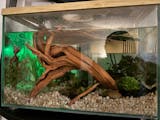Aquaticmotiv is very cautious in packing and shipping. Temperatures dropped after i ordered and shipment was held. Plants arrived late but in great health and they look great.
Description
AquaticMotiv Spider wood
Spider wood is a natural driftwood used in aquascaping to create stunning, branchy, root-like structures. It gets its name because its thin, twisted branches resemble spider legs. It’s a favorite among aquascapers for building miniature trees, root systems, or wild jungle scapes.
Key features:
-
Hardwood: It’s extremely dense and strong, which makes it durable and long-lasting in water.
-
Botanical Origin: Typically comes from Azalea or Rhododendron roots.
-
Appearance: Light-colored, wiry, and branchy with lots of fine, twisty arms - great for creating depth and detail.
-
Minimal Tannins: Unlike driftwoods like Malaysian or Mopani, it releases very little tannin, so your water won’t go super tea-colored.
-
Highly Decorative: Makes scapes look intricate and natural.
-
Shrimp & Fish Friendly: Lots of little nooks to explore and hide in.
-
Good for Planting: Perfect for tying moss, Bucephalandra, Anubias, and other small plants.
-
Natural Habitat Vibe: Mimics roots and submerged wood you'd find in rivers or streams.
-
Safe for Aquariums: It's non-toxic and safe for fish, shrimp, and plants.
How to prepare Spider wood
Most Spider Wood wood is ready for your tank but we still recommend some preparation.
1. Rinse Thoroughly
-
Rinse the spider wood under hot water.
-
Use a clean brush to scrub off any dirt, dust, or loose debris.
-
Don’t use soap or chemicals—only clean water.
2. Soak the Wood
Spider wood can float at first. Soaking it helps it:
-
Become waterlogged so it will sink.
-
Release tannins (which can tint water brown).
-
Soften the surface for attaching plants like moss or Anubias.
How to soak:
-
Submerge the wood fully in a large bucket or tub of clean water.
-
Place something heavy on top to keep it submerged.
-
Soak for a couple of days or as needed
-
Change water often to reduce tannins.
3. (Optional) Boil the Wood
If the piece fits in a pot, boiling it can:
-
Sterilize the wood.
-
Speed up the saturation process (it’ll sink faster).
-
Remove tannins more quickly.
Boil for 1–2 hours, replacing the water if it gets very dark.
4. Place in Your Aquarium
-
If it still floats, you can:
-
Weigh it down with rocks or substrate.
-
Zip-tie or glue it to a piece of slate or aquarium-safe weight.
-
Let it stay partially floating until it naturally sinks
5. Watch for Biofilm
-
You might see a white, slimy film appear after a few days in the tank.
-
This is normal and harmless.
-
It will disappear on its own or be eaten by shrimp/snails.
-
pictures above are a simple representation of the shapes you might get;
-
all our driftwood was pre-selected from our supplier;
-
you will always receive a piece with great aesthetics.















